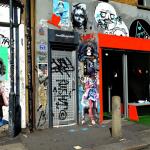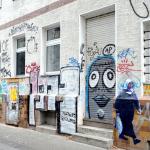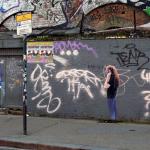Text by: Christina Grammatikopoulou
Bio
Click on any image to view gallery
Read more about the project here
.
A walk around the city is a world of sensations: the successive layers of history on the walls, the streets pulsing with life, the kaleidoscope of colours, the buzzing noises, the smell of the air, the vibration on the shoe soles as each step lands on the sidewalk.
Can this experience be reproduced through a cold sequence of 0 and 1?
Can you feel a city through browsing and clicking?
The dissection of the urban body by Google Street View results in a lifeless representation, a ghost of the city. And the human figures that are crystallized in the program become Street Ghosts.
Paolo Cirio’s project questions the established hierarchies within the internet and the city, through the unauthorized act of downloading copyrighted images and pasting them on the city walls. Like a hacker of the urban and virtual space, the artist subverts the established nodes of meaning in both places, so as to highlight the existing antinomies between free information flow and privacy rights, creation and commodification.
[From real space to virtual space]
The first part of the “hack” is actually carried out by a corporate giant, Google, which stores private data and misappropriates the cultural wealth of the city and the people that live inside it, by turning them into images with the Google copyright watermark printed across: a drainage of a living space in order to get information and commercial profit.
[From virtual space to the real space]
Paolo Cirio seeks photos of people in Google Street View, especially around the “Street Art Halls of Fame”: these “non-places” within the city –massive housing blocks, decadent neighbourhoods, crumbling corners- that become de-anonymized through the intervention of street artists. He subsequently prints those blurry figures in natural size and pastes them in the exact same spot where they were captured by the eye of the “big brother”.
In a way, Paolo Cirio’s Street Ghosts project returns those people to where they were originally found, the physical space; however their materiality is not fully restored. The images become colourful shadows absorbed by the walls, frozen in time, that remind us that life is oozing from every city street.
At the same moment, somewhere in the world, the Google street car keeps recording information, capturing more images of people.
But these are just empty shells. Their living counterparts are out there moving, feeling, creating.
.
ººººº
.
Un paseo por la ciudad es un mundo de sensaciones: las sucesivas capas de historia en las paredes, las calles latiendo con la vida, el caleidoscopio de colores, el zumbido de los ruidos, el olor del aire, la vibración en las suelas de los zapatos cuando cada paso aterriza en la acera.
¿Puede esta experiencia reproducirse a través de una secuencia fría de 0 y 1?
¿Puedes sentir la ciudad clicando y navegando?
La disección del cuerpo urbano por Google Street View da como resultado una representación sin vida, un fantasma de la ciudad. Y las figuras humanas que quedan cristalizadas en el programa se convierten en fantasmas de la calle, en Street Ghosts.
El proyecto de Paolo Cirio cuestiona las jerarquías establecidas dentro de Internet y de la ciudad, a través del acto no autorizado de descargar imágenes con derechos de autor y de pegarlas en muros de la ciudad. Como un hacker del espacio urbano y virtual, el artista subvierte los nodos de significado establecidos en ambos lugares, para subrayar las antinomias ocultas entre el flujo libre de información y el derecho a la privacidad, la creación y la mercantilización.
[Desde el espacio real al espacio virtual]
La primera parte del "hackeo" en realidad la lleva a cabo un gigante corporativo, Google, que almacena datos privados y “malversa” la riqueza cultural de la ciudad y de la gente que la habita, al convertirlos en imágenes que llevan la marca del copyright de Google: un drenaje de un espacio vivo para adquirir información y beneficio comercial.
[Desde el espacio virtual al espacio real]
Paolo Cirio busca fotos de personas en Google Street View, especialmente entorno a sitios típicos del Street Art: esos “no lugares” de la ciudad - bloques masivos de viviendas, barrios decadentes, esquinas desmoronadas - que se des-anonimizan a través de la intervención de artistas callejeros. Posteriormente, imprime esas figuras borrosas a tamaño real y las pega en el mismo lugar en que fueron capturadas por el ojo del “gran hermano”.
En cierto modo, el proyecto Street Ghosts de Paolo Cirio devuelve a esas personas al espacio donde fueron encontradas originalmente, el espacio físico; sin embargo, su materialidad no está completamente restaurada. Las imágenes se convierten en sombras coloridas absorbidas por las paredes, congeladas en el tiempo, que nos recuerdan que la vida rezuma de cada calle de la ciudad.
En el mismo instante, en algún lugar del mundo, el coche de Google Street View sigue grabando información, capturando más imágenes de gente.
Pero éstas no son más que cáscaras vacías. Sus equivalentes vivos están ahí fuera moviéndose, sintiendo, creando.
.
ººººº
.
Μια βόλτα στην πόλη είναι ένας κόσμος αισθήσεων: οι διαδοχικές στρώσεις ιστορίας στους τοίχους, οι δρόμοι που σφύζουν από ζωή, το καλειδοσκόπιο χρωμάτων, ο βόμβος των θορύβων, η μυρωδιά του αέρα, οι κραδασμοί στις σόλες των παπουτσιών με κάθε βήμα που προσγειώνεται στο πεζοδρόμιο.
Μπορεί να αναπαραχθεί αυτή η εμπειρία με μια ψυχρή διαδοχή του 0 και του 1;
Μπορείς να νιώσεις μια πόλη σερφάροντας και κλικάροντας;
Η ανατομή του σώματος της πόλης από το Google Street View έχει ως αποτέλεσμα μια αναπαράσταση δίχως ζωή, ένα φάντασμα της πόλης. Και οι ανθρώπινες μορφές που αποκρυσταλλώνονται στο πρόγραμμα μετατρέπονται σε φαντάσματα του δρόμου, σε Street Ghosts.
Το project του Paolo Cirio θέτει υπο αμφισβήτηση τις κατεστημένες ιεραρχίες στο internet και στην πόλη, δρώντας χωρίς εξουσιοδότηση: κάνει download εικόνων που προστατεύονται από το νόμο περι πνευματικής ιδιοκτησίας και τις κολλάει τους στους τοίχους της πόλης. Σαν ένας hacker του αστικού και ψηφιακού χώρου, ο καλλιτέχνης ανατρέπει τα υπάρχοντα νοήματα και στους δύο τόπους, ώστε να τονίσει τις υπάρχουσες αντινομίες μεταξύ της ελέυθερης διακίνησης πληροφοριών και των νόμων περι προσωπικών δεδομένων, μεταξύ της δημιουργίας και της εμπορευματοποίησης.
[Από τον πραγματικό χώρο στον ψηφιακό χώρο]
Το πρώτο κομμάτι του «hack» στην ουσία το πραγματοποιεί ένας εταιρικός γίγαντας, το Google, που αποθηκεύει προσωπικά δεδομένα και σφετερίζεται τον πολιτιστικό πλούτο της πόλης και των ανθρώπων που ζουν μέσα σε αυτήν, μετατρέποντάς τους σε εικόνες που έχουν τυπωμένο το υδατογράφημα της Google απ’άκρη σ’άκρη: μια απομύζηση ενός ζωντανού χώρου με σκοπό την απόκτηση πληροφοριών και εμπορικού κέρδους.
[Από τον ψηφιακό χώρο στον πραγματικό χώρο]
Ο Paolo Cirio βρίσκει φωτογραφίες ανθρώπων στο Google Street View, ειδικά γύρω από τους χώρους που είναι διάσημοι για το Street art: αυτούς τους «μη-τόπους» μέσα στην πόλη –τεράστιες πολυκατοικίες, παρηκμασμένες γειτονιές, φθαρμένες γωνιές- που βγαίνουν από την ανωνυμία μέσα από την παρέμβαση των street artists. Στη συνέχεια τυπώνει αυτές τις θαμπές εικόνες σε φυσικό μέγεθος και τις κολλάει στο ίδιο ακριβώς σημείο όπου τις συνέλαβε το μάτι του «μεγάλου αδελφού».
Κατά κάποιο τρόπο, το project του Paolo Cirio Street Ghosts επιστρέφει αυτούς τους ανθρώπους εκεί που βρέθηκαν εξ αρχής, στο φυσικό χώρο· παρόλα αυτά η υλική τους διάσταση δεν αποκαθίσταται πλήρως. Οι εικόνες μετατρέπονται σε χρωματιστές σκιές που απορροφώνται από τους τοίχους, παγωμένες στο χρόνο, που μας θυμίζουν ότι η ζωή ξεχύνεται από κάθε δρόμο της πόλης.
Την ίδια στιγμή, κάπου στον κόσμο, το αυτοκίνητο της Google Street View συνεχίζει την καταγραφή πληροφοριών, αιχμαλωτίζοντας και άλλες εικόνες ανθρώπων.
Όμως αυτές δεν είναι άλλο από άδεια κελύφη. Οι ζωντανές αντιστοιχίες τους βρίσκονται εκεί έξω και κινούνται, νιώθουν, δημιουργούν.
.
ººººº
.
Um passeio pela cidade é um mundo de sensações: sucessivas camadas de história nas paredes, ruas pulsando com vida, cores em caleidoscópio, zumbidos ruidosos, cheiros no ar, vibrações das solas dos sapatos quando cada passo é dado na calçada.
Esta experiência pode ser reproduzida em uma seqüência fria de 0 a 1?
É possível sentir uma cidade clicando e navegando na web?
Dissecar o corpo urbano por Google Street View resulta em uma representação sem vida, um fantasma da cidade. As figuras humanas cristalizadas no programa se convertem em fantasmas de rua, em Street Ghosts.
O projeto de Paolo Cirio questiona as hierarquias estabelecidas dentro da Internet e da cidade, através do ato não autorizado de baixar imagens protegidas com direitos autorais e colar nos muros da cidade. Como um hacker do espaço urbano e virtual, o artista subverte os diferentes significados estabelecidos em ambos lugares, para destacar as antinomias ocultas entre o fluxo livre de informação e o direito de privacidade, a criação e a mercantilização.
[Do espaço real ao espaço virtual]
A primeira parte do "hack" na realidade leva a cabo uma gigante corporação, Google, que armazena dados privados e malversa a riqueza cultural das pessoas que habitam a cidade ao converter em imagens que levam a marca do Google copyright: uma drenagem de um espaço vivo para adquirir informação e beneficio comercial.
[Do espaço virtual ao espaço real]
Paolo Cirio busca fotos de pessoas em Google Street View, especialmente nos lugares típicos de Street Art: esses “não-lugares” da cidade – favelas, bairros decadentes, esquinas desmoronadas - que saem do anonimato através da intervenção de artistas de rua. Posteriormente, imprime essas figuras desfocadas em tamanho real e cola no mesmo lugar em que foram capturadas pelo olho do “big brother”.
De certo modo, o projeto Street Ghosts de Paolo Cirio devolve essas pessoas ao espaço onde foram encontradas originalmente, o espaço físico; no entanto, sua materialidade não está completamente restaurada. As imagens se convertem em sombras coloridas absorvidas pelas paredes, congeladas no tempo, lembrando a vida que vai desaparecendo das ruas das cidades.
No mesmo instante, em algum lugar do mundo, o carro do Google Street View segue gravando informações, capturando mais imagens de pessoas.
Mas estas não são mais que meras carcaças. Seus equivalentes vivos estão do lado de fora, em movimento, sentindo e criando.
.
ººººº
.
Una passeggiata per la città è un mondo di sensazioni: gli strati di storia in sequenza nelle pareti, le strade palpitanti di vita, il caleidoscopio di colori, i ronzii rumorosi, l’odore dell’aria, le vibrazioni delle suole delle scarpe ad ogni passo sul cemento.
Può quest’esperienza riprodursi attraverso di una fredda sequenza di 0 e 1?
Si può sentire la città cliccando e navigando?
La dissezione del corpo urbano realizzata da Google Street View risulta essere una rappresentazione senza vita, un fantasma della città. E le figure umane rimangono cristallizzate nel programma convertendosi in fantasmi di strada, in Street Ghosts.
Il progetto di Paolo Cirio mette in discussione le gerarchie stabili di Internet e della città attraverso l’atto non autorizzato di scaricare immagini tutelate dal diritto d’autore per poi attaccarle nei muri delle città. Come un hacker dello spazio urbano e virtuale, l’artista sovverte i nodi del significato prestabilito in entrambi i luoghi e, in questo modo, ne evidenzia le antinomie occulte tra il flusso libero dell’informazione e il diritto alla privacy, tra la creazione e la mercificazione.
[Dallo spazio reale a quello virtuale]
La prima parte dell' "attacco hacker” in realtà viene realizzata da un gigante corporativo, Google, che conserva i dati privati abusando della ricchezza culturale della città e della gente che vi vive e li converte in immagini che portano il marchio copyright di Google: un drenaggio per acquisire informazione e beneficio commerciale.
[Dallo spazio virtuale a quello reale]
Paolo Cirio cerca foto di persone in Google Street View, specialmente quelle scattate nei tipici luoghi della Street Art: i “non-luoghi” delle città – blocchi massivi di palazzi, quartieri decadenti, angoli fatiscenti – che si deanonimizzano per mezzo dell’intervento di artisti di strada. Dopo di ciò, stampa queste figure in dimensioni reali e li affigge nello stesso posto in cui furono incontrate originalmente, cioè nello spazio fisico. Ciò nonostante, la loro materialità non è del tutto restaurata. Le immagini si convertono in ombre colorate assorbite dalla parete, congelate dal tempo che ci ricordano che la vita filtra ogni strada della città.
Nello stesso tempo, in qualche posto del mondo, la macchina di Google Street View continua a registrare informazioni, catturando più immagini che persone. Esse, però, non sono altro che gusci vuoti. I loro vivi equivalenti stanno fuori muovendosi, sentendo e creando.
.
















